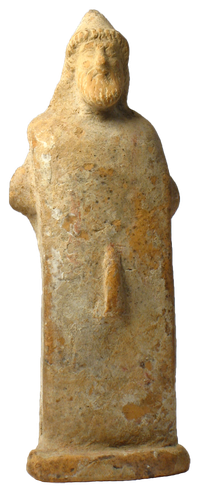Herm
Description: A small figure in the form of a slightly backward curved and inclined pillar with a bearded human head and an erect penis (Ithyphallos) indicated in bas-relief rises from a low plinth which is straight at the front and rounds towards the back. Shoulders are indicated at the top of the shaft. Further down are asymmetrical arm bosses, of which the lower left one is roundish in shape, while the higher right one appears more angular.
The elongated head covered with a pilos (pointed cap) merges into the oval of the beard. A thick crown of hair emerges from under the cap, its short smooth strands falling into the low forehead and framing the face. The subsequent undifferentiated section spreads to the shoulder on the right side[1].
The protruding compact full beard is lengthwise streaked, the upper lip beard curved. The flat arched upper cheek area emerges above it. The small mouth is closed. Under low orbits are large wide open eyes framed by band-like lids.
Commentary: The terracotta statuette from Giessen belongs to the type of shoulder herms[2]. It corresponds to the canonical herms, mainly made of marble, which are composed of a pillar-shaped shaft (Hermes tetragonos) with head, arm stumps and limb[3]. At the end of the 6th century BC, Hipparchus had 130 of them erected along the roads in Attica[4]. Hermes, the god of transition, had already been honoured in pre-Archaic times with cairns and aniconic (non-figurative) stone monuments erected to him at crossroads, borders, entrances and tombs[5]. Later, other deities and non-divine persons[6] were also depicted in the form of herms. The pointed cap, pilos[7], is the characteristic headgear of the god, along with the travelling hat, petasos[8]. Therefore, T I-15 is undoubtedly a Hermes herm. In motif and form, apart from the pilos and the rounded arm bosses, it resembles parallels in Munich and Berlin[9], with which it also agrees in the width of the shaft and the low height of the plinth. Other examples from Rhodes[10] and Klazomenai[11] are similar to the Giessen herm in iconographic terms, but differ slightly in proportions; in those the shafts are narrower, the plinths higher. The probable countries of origin of the comparative pieces are Rhodes and Boeotia (the latter for the specimen in Munich[12]).
The angular head and the cut of the eyes as well as the beard costume consisting of a compact chin and cheek beard and an ornamental upper lip beard suggest a dating to the Early Classical period[13]. Also since the beginning of the 5th century BC, bulging hair crowns and short smooth strands above the forehead have been part of the appearance of Hermes, also in representations made of other materials, for example in a gem[14], in bronze statuettes[15] and in vase painting[16]. With the undifferentiated long hair on the shoulder, which can be seen on casting T I-15 and some other terracotta herms, e.g. in Washington[17] and Berlin[18], one may have deliberately resorted to an ancient motif.
Determination: 1st half of the 5th century B.C. No definite clues can be gained as to the origin of the piece.
[1] Similar to the specimen in Washington, LIMC V (1990) 296 no. 19 pl. 200 s. v. Hermes (G. Siebert).
[2] H. Wrede, Die antike Herme (Mainz 1985) 2.
[3] E. Simon, Die Götter der Griechen (München 31985) 303-305.
[4] DNP V (1998) 422; „Dass sie aber Standbilder des Hermes mit aufrechtstehendem Glied darstellen, das haben sie nicht von den Ägyptern; sondern von den Pelasgern haben es als erste unter allen Griechen die Athener“ übernommen, Hdt. II 51, 1, ed. J. Weitz, Herodot, Historien, griechisch-deutsch (München 21977) 245-247.
[5] Simon ibid. 301; H. Goldman, The Origin of the Greek Herm, AJA 46, 1942, 58 f.
[6] Wrede ibid. 17-31; Porträthermen, ibid. 71-77.
[7] LIMC ibid. 222 f. nos. 246. 248. 252. 260. 263. 264. 265. 271. 284 pls. 221-223; F. W. Hamdorf, Die figürlichen Terrakotten der Staatlichen Antikensammlungen München (Lindenberg im Allgäu 2014) 223 f. nos. D 207. D 208; F. S. Knauß (ed.), Die unsterblichen Götter Griechenlands (Lindenberg im Allgäu 2012) 158 fig. 11.4; R. Lullies, Die Typen der griechischen Herme (Königsberg Pr. 1931) 15 no. 2 pl. 3; Winter I 1903, 231, 4; Winter ibid. 231, 3.
[8] LIMC ibid. 307 f. 316 nos. 192. 195. 208. 320, pl. 217 f. 227.
[9] Munich: Hamdorf 2014 ibid. 224 no. D 209; Berlin: A. Furtwängler, AA 4, 1890, 88 f. fig. B no. 5; Lullies ibid. 15 no. 5; Winter I 1903, 231, 5; LIMC V (1990) 296 no. 19 pl. 200 s. v. Hermes (G. Siebert); Chr. Blinkenberg, Lindos I. Les petits objets (Berlin 1931) 567 no. 2339 pl. 109; S. Mollard-Besques, Cat. Raisonné des figurines et reliefs en terre-cuite I (Paris 1954, no. C 139 pl. 77; LIMC ibid. no. 297 no. 29 pl. 201.
[10] Rhodos IV 1931, 196 fig. 204. 205.
[11] LIMC ibid. 296 no. 18 pl. 200.
[12] Hamdorf ibid. 224 no. D 209.
[13] B. Schmaltz, Terrakotten aus dem Kabirenheiligtum bei Theben (Berlin 1974) 170 no. 232. 233 pl. 19; 128 no. 347 pl. 27.
[14] LIMC V, 307 no. 192 pl. 217.
[15] LIMC V, 311 no. 262 pl. 222.
[16] Ebenda 315 no. 316 pl. 227.
[17] LIMC V (1990) 296 no. 19 pl. 200.
[18] Furtwängler ibid. 88 f. fig. B 5; Winter I 1903, 231, 5.




